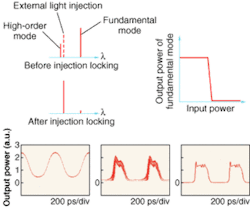An optical device based on a vertical-cavity surface-emitting laser (VCSEL) demonstrated waveform inversion of a 5-GHz sine wave, according to researchers at Tokyo Institute of Technology (Tokyo, Japan) and Corning (Corning, NY).1 An efficient, robust all-optical inverter is one step toward building all-optical signal-processing equipment. Yutaka Onishi and Fumio Koyama in Japan and their colleagues at Corning (Rochester, NY) used an injection-locking technique that resulted in a waveform inversion with an extinction ratio of greater than 20 dB.
Today, several signal-processing functions in computing and telecommunications require that optical signals be converted to electrical ones. All-optical systems make conversion unnecessary and would be more efficient, as well as potentially faster and more compact. Optical inverters based on various types of diode lasers have been demonstrated since 1990. In a number of these, injection of light near the first higher-order mode strongly encourages lasing at that wavelength and suppresses the output from the fundamental mode (see figure). This is the same technique used for this new work on 1.55-µm VCSELs.
Vertical-cavity surface-emitting lasers are attractive for optical processing because they offer low power consumption, dense packaging, and a circular output beam. "Edge-emitting lasers typically show large polarization sensitivity, which will be potentially avoided in VCSELs," says Onishi. "This should be particularly important for optical signal processing."
The inverter uses an indium phosphide-based VCSEL with a 7-µm circular tunnel-junction aperture, first developed by Corning researchers and co-authors of this work Nobuhiko Nishiyama and Catherine Caneau, among others.2 Because this design combines a tunnel-junction current aperture and n-type indium gallium aluminum arsenide/dielectric distributed Bragg reflectors, it has low absorption loss and can therefore provide high output powers.
Light from a tunable laser diode is injected into the VCSEL and output from the VCSEL is collected, both in a single lensed fiber. An optical circulator separates the injection-locking and output light. The researchers intentionally moved the fiber away from the center of the VCSEL to couple the external light more efficiently into the VCSEL's first higher-order mode. This mode was split into two wavelengths corresponding to two spatially orthogonal transverse modes, and the researchers chose the shorter wavelength for injection-locking. "The detuning between the wavelength of the input light and that of the first high-order mode of the free-running VCSEL," they write, "was set to be 0.15 nm." The input light was polarized to be orthogonal to that of the shorter wavelength.
The researchers noted that the mode switching occurred abruptly at two input powers. When the power was increasing, the output switched from fundamental to first higher-order mode at 0.9 mW. When the power was decreasing, it stayed in the higher order until it abruptly switched back at 0.25 mW.
The VCSEL's threshold current was0.8 mA, and the bias current was 5.6 mA. The higher-order light and injection-locking light were filtered out before the fundamental-mode light was measured. The switching depends strongly on the polarization. The researchers believe they can reduce the polarization dependence by changing the shape of the active aperture. They were able to reduce the polarization-dependence in a similar VCSEL.
Inverting a signal
Onishi and colleagues then added a lithium niobate modulator to the setup, inserting it in front of the tunable laser diode. When they fed a 1-GHz sine wave into the VCSEL, they received an inverted—and somewhat reshaped—wave out. The group's calculations accounted for the shape of the output. "We can manipulate the width of the output wave by adjusting the detuning," says Onishi.
The limiting factor on speed for the inverter is the optical-modulation bandwidth of the VCSEL. Some of the authors (Nishiyama and colleagues) recently demonstrated a 1.55-µm VCSEL that offered electrical modulation at more than 10 Gbit/s, so the authors are confident that the speed could be increased for this inverter in the future. The group recently demonstrated that the polarization dependence can be decreased to as low as 10%, and is working to increase the speed and decrease polarization dependence.
REFERENCES
- Y. Onishi, et al., IEEE Photon. Tech. Lett. 16(5), 1236 (May 2004).
- N. Nishiyama, et al., Electron. Lett., 39(5), 437 (2003).
Yvonne Carts-Powell | Freelance Writer
Yvonne Carts-Powell is a freelance writer living in Belmont, MA.
